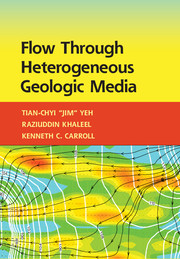Book contents
- Frontmatter
- Contents
- Preface and Acknowledgments
- 1 Fluid Statics and Dynamics
- 2 Darcy's Law for Saturated Porous Media
- 3 Darcy's Law for Unsaturated Porous Media
- 4 Stochastic Conceptualization of Heterogeneity
- 5 Governing Flow Equations for Heterogeneous Media Conceptual Models
- 6 Equivalent Homogeneous Media Conceptual Models
- 7 Flow toward a Well Due to Pumping (Part 1)
- 8 Flow toward a Well Due to Pumping (Part 2)
- 9 Stochastic Approaches
- References
- Index
6 - Equivalent Homogeneous Media Conceptual Models
Published online by Cambridge University Press: 05 July 2015
- Frontmatter
- Contents
- Preface and Acknowledgments
- 1 Fluid Statics and Dynamics
- 2 Darcy's Law for Saturated Porous Media
- 3 Darcy's Law for Unsaturated Porous Media
- 4 Stochastic Conceptualization of Heterogeneity
- 5 Governing Flow Equations for Heterogeneous Media Conceptual Models
- 6 Equivalent Homogeneous Media Conceptual Models
- 7 Flow toward a Well Due to Pumping (Part 1)
- 8 Flow toward a Well Due to Pumping (Part 2)
- 9 Stochastic Approaches
- References
- Index
Summary
Introduction
This chapter discusses mathematical models of the equivalent homogeneous media conceptual model. As stated in Chapter 5, this conceptual model expands the laboratory-scale control volume (CV) (see Chapter 2) to a field-scale CV. This field-scale CV is sufficiently large to include heterogeneities at scales much greater than pores (such as layers, zones, and formations). If the hydraulic properties of a medium, defined over this CV, are spatially invariant at a field site, this medium is then considered to be spatially homogeneous, and a spatial REV exists. The hydraulic property field of this medium is thus considered a realization of a stationary process (see Section 4.7 of Chapter 4). On the other hand, if the spatial REV does not exist, the property field is a realization of a nonstationary process. Nevertheless, this medium can still be treated as homogeneous over the entire field site. This homogenization of this geologic medium is tantamount to saying that an REV exists only in the ensemble sense (ensemble REV or ensemble stationarity), rather than in the spatial sense. That is, the spatial statistics of the medium property over this site are identical to the spatial statistics of all other possible realizations at the same site. As a consequence, the predicted behavior at any location based on this equivalent homogeneous model represents the ensemble-averaged behavior at that location, resulting from all possible heterogeneities over the entire field. Since the heterogeneity is nonstationary, its variance must be large, and the ensemble-averaged behavior likely deviates greatly from the observed behavior. This model thus yields low resolution predictions (see Section 6.7 and Chapter 9).
Despite its low resolution predictions, such an equivalent homogeneous conceptual modeling approach has been widely adopted over the past decades. Its popularity is largely due to our limited ability to derive analytical solutions for governing equations for flow and solute transport in complex heterogeneous media, in addition to our inability to characterize heterogeneities at different scales in detail. The homogeneous conceptual model undoubtedly offers practical solutions to complex problems, but it confronts many other issues. For instance, how can the hydraulic properties (effective hydraulic properties) of this equivalent homogeneous conceptual model be defined? How different is the predicted aquifer behavior based on the approach from the observed behavior in the field? These topics are discussed in this chapter.
- Type
- Chapter
- Information
- Flow through Heterogeneous Geologic Media , pp. 175 - 206Publisher: Cambridge University PressPrint publication year: 2015



